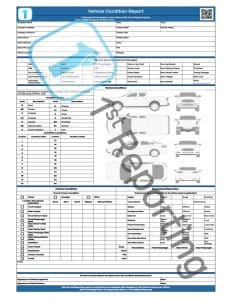


Do you need to document commercial vehicle asset inspections using a Vehicle Condition Report? Finding an appropriate vehicle inspection template can be challenging, as there are so many “bait and switch” results in the search. Well, fret no more—we’ve got your back with a free, downloadable template.
A Vehicle Condition Report provides a solution for containing all the observations of an inspection in an organized manner. The downloadable template you can access below is a complete printable solution for your vehicle condition inspection needs.
We’ll explain the template briefly and provide some best practices to help you get your inspection process running smoothly. We’ll then ensure that a digital document solution is addressed. That is, one that you can run on your company smartphone in case a downloadable form isn’t an option.
Table of Contents
When inspecting a vehicle’s condition, whether at your facility or on a remote site, you need a working solution. Your business and customers rely on solutions. So here’s what we’ve included in the vehicle inspection report template you can see below (it is watermarked; the downloadable version does not contain a watermark).

The Vehicle Condition Report has five essential components you need to cover all the information required for vehicle inspections. Here’s a breakdown of the sections you will find:
There are four primary components to the administrative information area of vehicle condition reports. These areas consist of:
Vehicles come in a wide array of options: a used vehicle, a vehicle online, a new vehicle from a dealership, or a rental automobile. In order to identify the vehicle condition, it is essential to know all the detailed vehicle-based options. The vehicle options identification section has the majority of standard options from wide tires to car or truck drive type.
The primary and central component to our vehicle condition report includes a standard extended cab truck diagram and a four-door sedan. The concept is that the vehicle condition report will work for either cars or trucks. However, the report is intended to record the observations from a vehicle inspection of a single car or truck. Not both in one report.
Naturally, there are far too many body types to include within the page, so two common forms are our solution.
The left half of the vehicle condition section has a legend that explains the various issues one might observe and their corresponding code. Following this is an area where the vehicle condition observer might record the locations and observations noted on the vehicle diagrams via a numbering system.
If further clarity is required, we will explain in greater detail in the best practices section of this template guide.
The interior vehicle condition observations are recorded in this section of the vehicle condition report. The process involves a checklist table of locations within the car or truck’s interior. The observer may note their feedback via the checklist columns denoting the condition. Similarly, there is a short section at the end where feedback concerning any other issue not listed previously may be recorded when the inspector creates the condition report.
The mechanical and operational systems of the vehicle are recorded in this section. Again there is a checklist table with the various indications of issue or repair required. The repairs or service needed to the tires may also be recorded in the subsequently included section.
At the end of the document are two more final segments: a notes section and the document sign-off.
The note section of the vehicle condition report allows the inspector to include further observations about the car or truck, not included prior.
Lastly, you will find the sign-off area on the vehicle condition report. We have included both a place for an inspector and also a vehicle driver to sign and date the report to be accurate. A missing date is an issue when trying to resolve condition report discrepancies, so ensure it is completed accurately.

Completing vehicle condition reports is essential whether you operate dealerships or a rental agency. Even if you are running neither, any business or organization that intends to purchase cars or trucks for their fleet will find using a vehicle condition report essential to operations.
Here are the best practices you can train your vehicle inspectors with in order to better assist your inspection process:

Printed reports are great, but the next best thing might just be the best solution. How do we maintain accurate reporting when paperwork can be lost, or handwriting might not be legible? The solution is to use a digital solution for your vehicle condition reports.
Technology allows us to put the printer away, save paper (and trees), save money (ink isn’t cheap), and allow for many extra possibilities. For example, with a paper checklist, you cannot report using images or video. However, a cloud-based solution can offer your inspectors the ability to include images or even video when they create the inspection report.
Cloud-based solutions mean that you can access your reports on the Internet. Typically, this technology includes the use of websites and innovative technology like smartphones or tablets.
Using a digital form automation solution like the 1st Reporting app is a great way to ensure a detailed report. Everyone from a car dealership to car buyers can appreciate an efficient way to capture information about a vehicle’s condition, so a detailed report is wise.
Including an image or two in the observations says much more than words can in a shorter time. It increases reporting efficiency. As a business manager, you understand that time is money, so if we can improve reporting efficiency, we won’t be doing anything wrong, that’s for sure.
Utilizing a light and easy-to-use app that allows tracking and reporting via internet access is a more efficient way of recording vehicle conditions. Whether at your facility location or a remote location, being mobile can really help to ensure conditions are recorded on the spot where observations are the freshest.